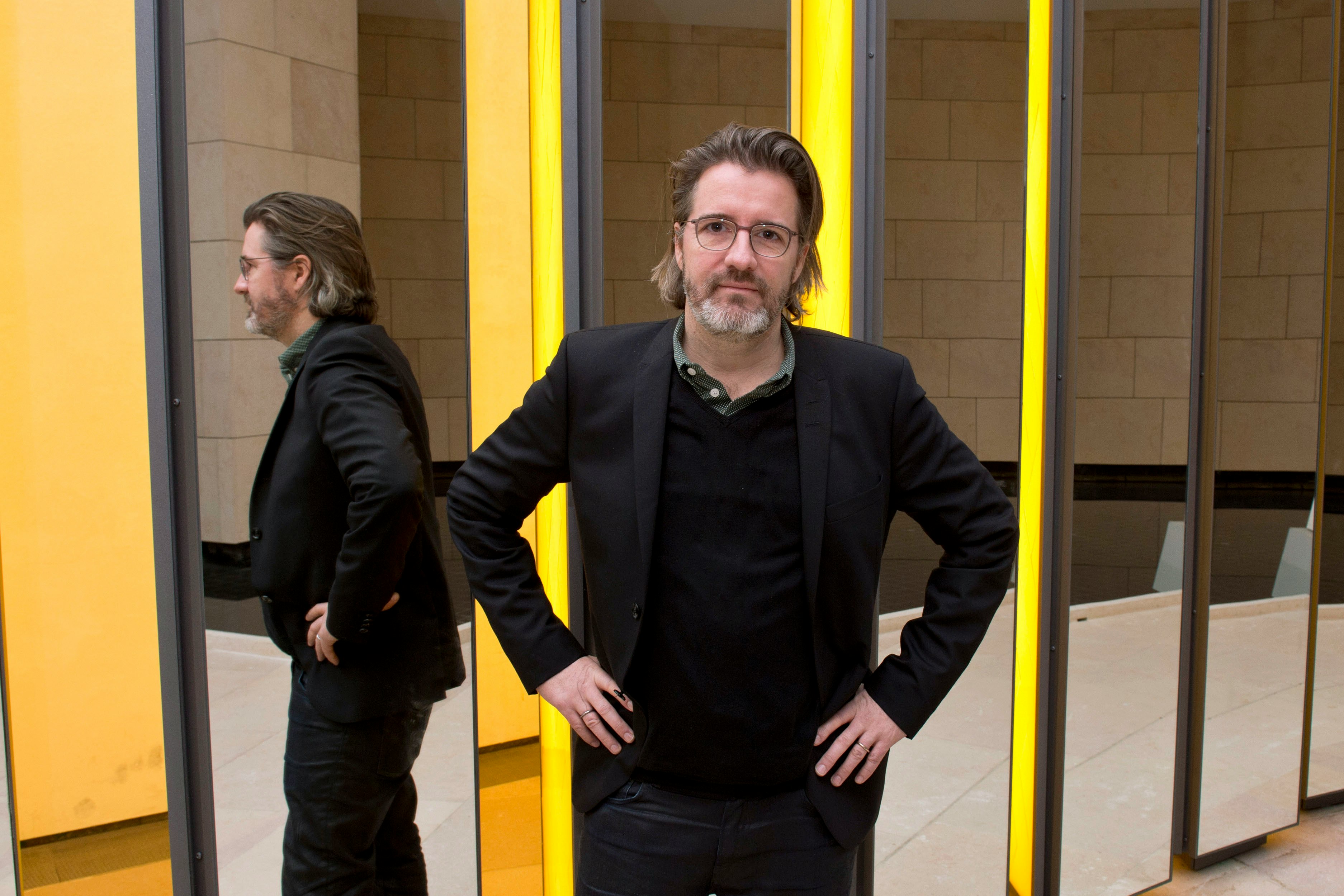As part of the exhibition Olafur Eliasson: contact, a programme proposed by Olafur Eliasson
- Date
- From 14.02.2015 to 15.02.2015

Saturday february 14th - 7:30 pm
Screening : ‘Contact by Olafur Eliasson’ a film by Claire Denis
Photographed by Agnès Godard and Yorick Le Saux
Original Music by Stuart Staples
In Association with the Fondation Louis Vuitton
© The Apocalypse Films, Alcatraz Films and Studio Olafur Eliasson
In 2014, Claire Denis and Olafur Eliasson connected for the first time to explore their fascination for phenomena not yet explained by science, like black holes, and discovered along the way a shared confidence in abstraction. From their dialogues emerged a three-minute film contemplating Eliasson’s artwork Contact and the feeling of infinity that its intense yellow light inspires.
Denis's film premieres on 14 and 15 February at Fondation Louis Vuitton as part of the public programme accompanying Eliasson’s exhibition.
Duration: 3 minutes
Concert : Samuli Kosminen & Matti Bye ‘ Live at Fondation Louis Vuitton’
For the Fondation Louis Vuitton, Kosminen and Bye perform a concert that draws power from their shared background in cinematic, visual soundscapes. Staged in front of a view that opens to Olafur Eliasson´s extensive "Inside the Horizon”, the concert acts as an epilogue to Kosminen´s and Eliasson´s written collaborative sound composition.
Composers Samuli Kosminen and Matti Bye have made a name for themselves in the vanguard of musical innovation. Both Kosminen, originally a drummer, and Bye, a silent movie pianist, are known for pushing the sonic boundaries of their respective instruments through electronics and experimentation. Adventurous and sensitive, they express themselves through the delicacy and fervor of improvisation.
Samuli Kosminen: Prepared drums & percussion and live electronics
Matti Bye: Piano and live electronics
Dimanche 15 février - 17H30
Screening : ‘Contact by Olafur Eliasson’ a film by Claire Denis
Photographed by Agnès Godard and Yorick Le Saux
Original Music by Stuart Staples
In Association with the Fondation Louis Vuitton
© The Apocalypse Films, Alcatraz Films and Studio Olafur Eliasson
In 2014, Claire Denis and Olafur Eliasson connected for the first time to explore their fascination for phenomena not yet explained by science, like black holes, and discovered along the way a shared confidence in abstraction. From their dialogues emerged a three-minute film contemplating Eliasson’s artwork Contact and the feeling of infinity that its intense yellow light inspires.
Denis's film premiere on 14 and 15 February at Fondation Louis Vuitton as part of the public programme accompanying Eliasson’s exhibition.
Duration: 3 minutes
Concert : Elemental II (Solo for electric bass, 2004) - Elemental II (Solo for electric bass, 2004)
Composition : Eliane Radigue
Performance : Kasper Toeplitz
In 2004, at the request of the bassist and electronic composer Kasper T. Toeplitz, the first instrumental work by Éliane Radigue, Elemental II, was recorded on the R.O.S.A. (Recordings Of Sleaze Art) label, which Toeplitz created specially for the launch of the work (the piece was then taken up by the laptop improvisation group The Lappetites, which she joined, participating in their first album Before the Libretto on the Quecksilber label in 2005). Since then, she has devoted herself to the creation of purely acoustic works for instruments.
This is the meeting point of her previous electronic output and her later acoustic work - the bass is an instrument conceived here as a passage between two worlds. Since its performance in Paris at Festival Cités Soniques/Sonic Cities on 24 January 2004, Elemental II has been played more than thirty times around the world (including Mono:ton Festival EMS Stockholm, Sonic Acts Festival Amsterdam, Huddersfield Festival UK, Red Cat Los Angeles, etc.) and contributed significantly to the rediscovery of Éliane Radigue's works.
2 CDs were issued on the R.O.S.A. label and distributed by Metamkine: one in 2004 and the other in 2011.
The artists
Claire Denis
Claire Denis is a French film director and screenwriter. She is also a professor at the European Graduate School in Switzerland and Femis in France. As a filmmaker she is best known for her style that emphasizes outdoor settings rather than shooting in the studios. Her films question love, desire while music plays a vital role.

Samuli Kosminen
Samuli Kosminen is one of Finland’s top drummers/percussionists. As a musician, composer and producer, Kosminen has collaborated with numerous renowned Finnish and foreign artists such as the Kronos Quartet, Hauschka, Jónsi (from Sigur Rós), Valgeir Sigurðsson, Emiliana Torrini, Trey Anastasio, Death Vessel, Sasha Siem, Pekka Kuusisto, Matti Bye, WHS (a Finnish contemporary circus and visual theater group) and many others. He has been featured on over 80 albums.
For the past decade his main collaborators have been the Icelandic band Múm and the Finnish accordionist Kimmo Pohjonen.Originally as drummer, now as an explorer of flea-market percussions, beat apparatuses, melody making toys, clonky machines and tuneful data processors, Kosminen has discovered new and strange dimensions of rhythm and sound. In collaboration with Olafur Eliasson, he realized a specific sound composition for Inside the horizon for the Grotto.
Perceived as a "soundscape", this composition is diffused through twenty speakers along the installation. Designed from recordings made in the artist's studio, the sound work oscillates between raw material, concrete and electronic music sound sometimes leaving visitors uncertain as to the real nature of what they hear. While the visitors move between the columns, space and sound meet through movement. Additional sound elements by Kosminen and Eliasson are audible at particular spots within the exhibition.

Matti Bye
Matti Bye started his career 25 years ago composing and doing live improvisations to silent film and early cinema. Using similar methods and in light of his special sensitivity, while developing his experience face to face with the screen, he is now focusing on the music of contemporary film and tv productions.
This year Bye received several prizes including two nominations and winner of Guldbagge for the music to the Film, Faro, plus the Nordic film music price; Harpa. Matti Bye has also collaborated and written filmscores for Jan Troell, Maria Larsson’s everlasting moments, where he also received a Guldbagge for 2009.
He also recently made music for “Pictures from a Playground,” a documentary about Ingmar Berman, and for the comedy "One hundred man that climbed out a window and disappeared" (Centenarian). He is a regular solo performer and composer and also performs and composes with his ensemble for silent film festivals and screenings around the world. Bye significantly contributes to the exploration of the alchemy between sounds and images. www.mattibye.com

Éliane Radigue
Éliane Radigue started working with musique concrète in the 1950s as a student of Pierre Schaeffer at the Studio d'Essai.
In 1967 she was Pierre Henry's assistant and took part especially in the creation of his Apocalypse de Jean. Her first compositions already differed from the principles of musique concrète: instead of clashing with sound objects, this music involved superimposing held notes (bourdons or drones) that unfold, working first with audio feedback, then synthesisers. The ARP 2500 model was her main tool in more than thirty years of solo work, during which she patiently composed long minimalist works: Geelriandre (1972), Psi 847 (1972), Adnos (1974). In 1974, she converted to Tibetan Buddhism and subscribed to the teachings of the master Pawo Rinpoche. After a break, she returned to her musical compositions with works such as Adnos II (1979), Trilogie de la Mort (1985-1988) - a triptych marked by the death of her son Yves Arman– Jetsun Mila, and L'Île Re-sonante (2001), her latest work on tape. Since 2004, the date of her composition Elemental II for electric bass (with Kasper Toeplitz), Éliane Radigue has devoted herself exclusively to instrumental work, which is an extension of her electronic work without any aesthetic break. For the composer, who has always worked alone, the close collaboration with performers during the composition process was a revelation. In June 2011 in London, Sound and Music paid tribute to all her works (source: Festival d'Automne à Paris, 2013).

Kasper Toeplitz
The composer and musician (computer, electric bass) Kasper Toeplitz developed his work in the no-man's land between 'academic' composition (orchestra, ensembles, opera) and the electronic music, or 'noise music'. Kasper T. Toeplitz developed his compositions based on dense, unfolding sound material; electronic architectures that are studies of time, the immobility or clamour, that can be written for instrumental groups or computers played as a distinct instruments. The use of computers has led him to work in other fields (image, light), applying to them the idea of silent music, or even to work in close collaboration - and directly - with other artistic disciplines, especially contemporary dance.
He has received several prizes and distinctions in the academic field as well as numerous public, radio or electronic music studios commissions, such as Ircam, GRM , GMEM, CRFMW and EMS. He also works with experimental or unclassifiable musicians such as Zbigniew Karkowski, Tetsuo Furudate, Dror Feiler, Art Zoyd, Éliane Radigue, Phill Niblock, Francisco Lopez, Z’ev and Ulrich Krieger, as well as artists in other disciplines, such as dance and video. The dance/music collaboration with Myriam Gourfink has lasted for more than fifteen years and includes more than twenty-five joint works, the most recent being Souterrain (2014), Abois (2013), Déperdition (2013), Aranéide (2013) and the next work Almasty (February 2015).
His discography includes more than fifty titles. All these recordings are distributed by Metamkine.com
www.sleazeart.com


